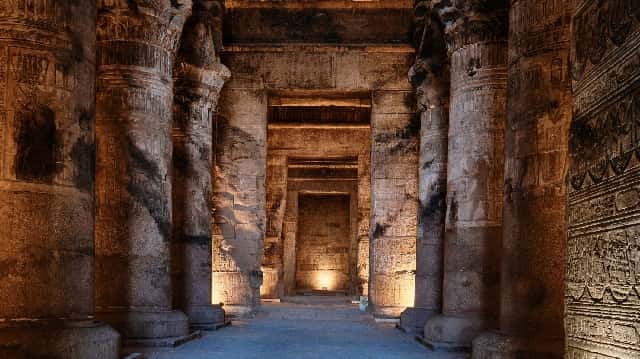
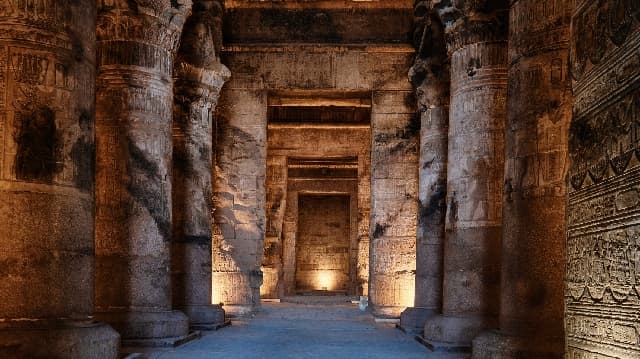
Travel through time at Hathor Temple, a place where love, astronomy, and ancient rituals blend in stunning carved stone.
The Hathor Temple, centerpiece of Egypt’s Dendera Complex, honors Hathor, goddess of love, music, and motherhood. Built between 225 BCE and 100 CE, it remains one of Egypt’s best-preserved temples. Highlights include a grand hypostyle hall, celestial ceiling of goddess Nut, sacred birth houses, hidden crypts, and the famed Dendera Zodiac. Recent finds, like a sphinx of Emperor Claudius, continue to reveal its secrets. The temple stands as a powerful symbol of ancient Egyptian art, spirituality, and cosmic belief.
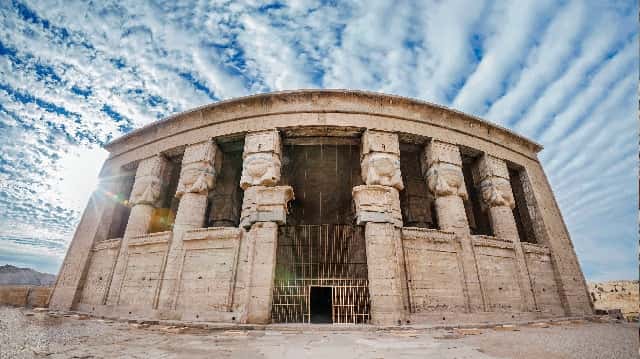
The Dendera Temple Complex, dating from the late Ptolemaic to Roman era, is a well-preserved religious site centered on the Temple of Hathor, dedicated to the goddess of love and music. It reflects a blend of Egyptian and Greco-Roman culture and offers key insights into ancient worship and daily life.
Known for its Hathor-headed columns and vast Hypostyle Hall with celestial ceiling art, the temple includes chambers for rituals and a rooftop chapel used in festivals, showcasing the close link between its design and spiritual practices.
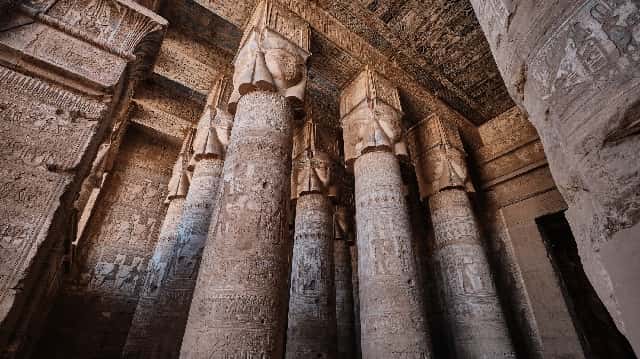
Hathor Temple’s walls and ceiling feature ancient carvings depicting gods, pharaohs, and cosmic cycles—offering deep insight into Egypt’s spiritual heritage.
A notable relief shows Cleopatra VII and her son Caesarion presenting offerings to Hathor, symbolizing the last era of pharaonic art and the blend of Egyptian-Roman power. Cleopatra’s identity as “New Isis” highlights her divine status.
The ceiling’s Rectangular Zodiac displays the goddess Nut and celestial motifs, reflecting Egypt’s advanced astronomy and the link between heaven and earth.
The hypostyle hall’s 24 Hathor-headed columns symbolize music and joy. Despite some fading, the carvings convey rich religious meaning.
Fourteen crypts under the temple stored sacred statues and ritual objects; a few are open to visitors, revealing intricate reliefs like Hathor’s hawk.
One crypt carving shows a serpent from a lotus, often misread as ancient electricity, but actually depicts the creator god Harsomtus in mythological symbolism.
The roof hosted New Year rituals with Hathor’s Ba statue and includes a chamber with carvings of Osiris’s death and rebirth, central to Egyptian faith.
Hathor Temple remains a vital cultural site, with ongoing restorations and discoveries revealing its ancient secrets.
Hathor was a major deity of love, music, and protection, worshipped by all genders and central to Egyptian religious life.
Conservators have restored vibrant colors and structural elements, bringing the temple’s original beauty back to light.
The temple continues to inspire art, scholarship, and tourism, keeping its history and symbolism alive today.
Hathor was a major Egyptian goddess of love, music, fertility, and protection, widely worshipped and symbolized as a cow or woman with cow ears. She influenced daily life and religious rituals, connecting closely with gods like Ra and Horus.
Hathor and Horus were linked as mother/consort and son, representing divine order and protection. Their bond is central in Egyptian mythology, celebrated in temple art and reflecting cosmic balance.
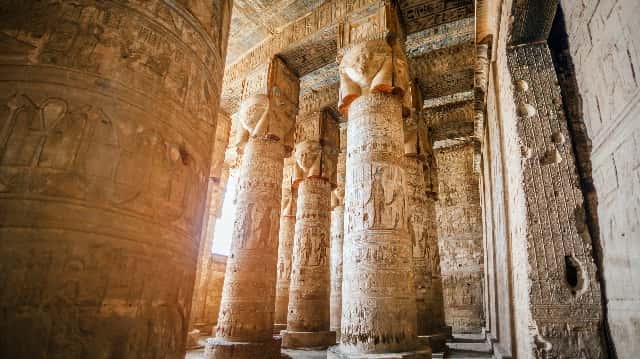
Central highlight of the complex
Noted for its grand architecture and intricate carvings
Features the impressive Hypostyle Hall with towering, decorated columns
Located on the chapel ceiling within the Temple of Hathor
A detailed astronomical bas-relief illustrating ancient Egyptian star knowledge
One of the best-preserved depictions of the celestial sphere
Attracts scholars and astronomy enthusiasts worldwide
Hidden chambers beneath the temple
Contain well-preserved carvings and hieroglyphs
Once used to store sacred ritual objects
Feature depictions of Hathor and other deities
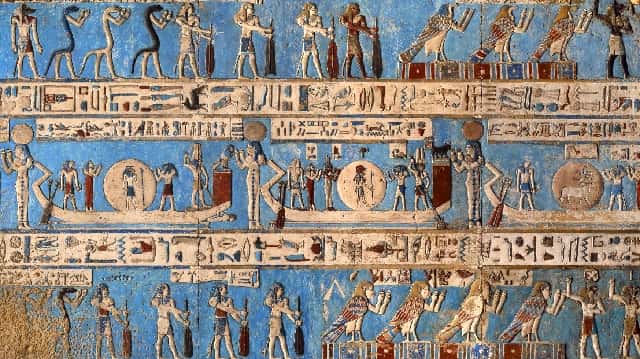
Enter through the Gateway of Domitian and Trajan to discover Hathor Temple—distinct for lacking a traditional pylon or colonnade, setting it apart from typical Egyptian temples.
Enclosed by mudbrick walls, the complex features birth houses, a sacred lake, a healing sanatorium, and Coptic basilica ruins. Its design reflects deep religious and astronomical significance.
Marvel at the hypostyle hall’s 18 Hathor-headed columns and the restored ceiling of sky goddess Nut. Explore crypts and the unique healing center, rare in ancient Egypt.
Photos are allowed (no flash). The rooftop offers sweeping views and access to the Chapel of Osiris with its detailed resurrection reliefs.
Visit from October to April for cooler weather. Wear good shoes, bring water, and consider a guided tour for deeper insight into this sacred site.
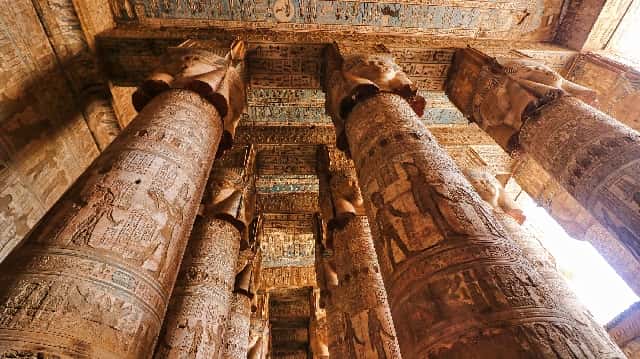
The Hathor Temple at Dendera is a well-preserved symbol of ancient Egypt’s culture, art, and religion. Its unique architecture, vivid restorations, and ongoing discoveries keep its history alive. More than a monument, it connects us to ancient beliefs and rituals, inviting exploration and wonder. This temple remains a powerful link between past and present, captivating visitors and scholars alike.
The Hathor Temple is part of the Dendera Temple Complex, located near the city of Qena in Upper Egypt, along the Nile River.
Hathor was the goddess of love, music, fertility, and motherhood. She was also seen as a protector of women and a symbol of joy and beauty.
Unlike many temples, the Hathor Temple is famous for its remarkably well-preserved artwork, vibrant colors, and the celestial zodiac ceiling depicting the sky goddess Nut. It also features distinctive columns topped with Hathor’s face.
Construction began during the late Ptolemaic period and was completed under Roman rule, around 54 BCE to 20 CE.
Yes, the Hathor Temple is open to tourists and is one of the major attractions within the Dendera Temple Complex.
Highlights include the hypostyle hall with its 24 columns, the stunning zodiac ceiling, carvings of Cleopatra and Caesarion, and hidden crypts beneath the temple.
Accessibility can be limited due to the temple’s ancient design and narrow crypt passages. It’s recommended to check with local guides or tour operators for detailed accessibility options.
Recent restoration efforts have cleaned the temple walls and columns, revealing bright pigments and intricate carvings, helping visitors see the temple as it might have looked in ancient times.
The temple is dedicated to Hathor, who was linked to many myths involving fertility, motherhood, and protection. It also features mythological scenes of gods like Horus and Osiris.
Yes, many tour companies offer English-speaking guides who provide detailed historical and cultural explanations during visits.
The cooler months, from October to April, are generally best for visiting Egypt due to milder temperatures.
A visit usually takes 1 to 2 hours, depending on your interest level and whether you explore the crypts and surrounding complex.
Photography is generally allowed, but it’s advisable to confirm specific rules on-site, especially regarding flash photography, to protect the artwork.
The nearby Dendera Temple Complex includes other temples and ruins, and the city of Qena offers cultural and historical attractions as well.
Yes, in March 2023, archeologists unearthed a limestone sphinx statue near the temple, possibly representing Roman Emperor Claudius. The discovery included a stele with inscriptions that may provide more historical information once deciphered.
A luxury Nile cruise takes you to Hathor Temple—where Egypt’s sacred joy and timeless elegance meet in your dream luxury trip.
